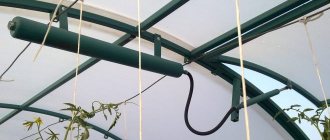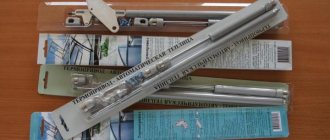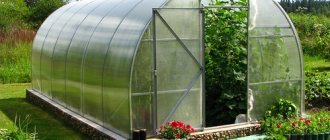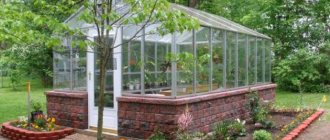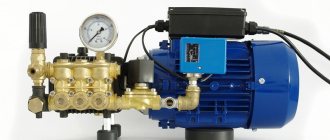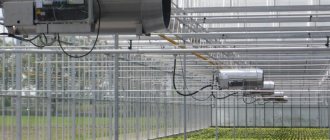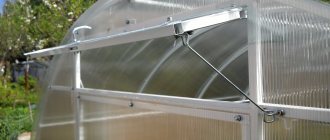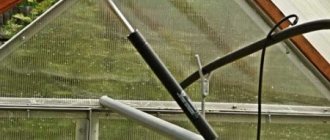To avoid overheating or freezing of plants, you must always maintain comfortable conditions in the greenhouse. You should always remember that the success of growing plants in a greenhouse depends on many factors: humidity, temperature, soil quality, seasonality, lighting and many others. We can influence and improve some factors, but not others. But it is not enough to simply ventilate the room - open the windows in the morning and close them in the evening. If the temperature drops below the required level or a draft occurs, this can negatively affect heat-loving plants.
High-quality ventilation of greenhouses plays an important role in growing plants. Ignoring this need has a negative impact not only on the development of plants, but also on the ripening of the fruit.
An automatic ventilation system with a special closer on the window allows you to avoid overheating the air in the greenhouse. We will tell you in our article which window opener is better to install, what advantages it has and how this device is installed.
What is a thermal drive?
A thermal actuator is a device that allows you to automatically control the position of the sash in the greenhouse, open or close at a specific (preset) temperature. It helps in maintaining the desired climate parameters and replenishing carbon dioxide without human intervention. Thanks to this device, the cultivation of plants and other crops proceeds safely and with minimal human intervention.
Fully opening the door at a temperature of +26 degrees ensures effective ventilation of the greenhouse. Fully closing the sash at temperatures below +22 allows you to retain heat in the greenhouse. Cells with an installed automatic ventilator can be opened even in frosts down to -50 degrees without fear that something will break.
Why do you need a thermal drive?
A greenhouse is installed for specific purposes - to retain heat and protect plants from unfavorable climatic conditions.
However, timely ventilation of the structure is no less important. An automatic ventilator allows you to get rid of excess moisture and reduce the air temperature to the optimum.
This device can be installed on any greenhouse: polycarbonate, glass and film.
If the design is glass, you should be especially careful when choosing a drive, since a glass window has a significant mass and will require a more powerful device to operate it.
In addition, the size of the greenhouse matters. It makes no sense to install this system on a greenhouse whose area is 1-2 square meters. m.
Dimensions and installation features
Windows help regulate indoor humidity and temperature.
How many windows should there be in a greenhouse?
For high-quality ventilation, experts recommend installing 1 opening transom for every 2 linear meters of the greenhouse; the final number of pieces is determined by the location of the structure. On average, according to reviews from experienced gardeners, the required amount is:
- Up to 3 m / n buildings - 2 pieces, at least 1 if the structure is located on the sunny, well-ventilated side of the site;
- 4 m/p - 1-2 pcs.;
- 6 m/p – 3-4 pcs.;
- 8 m/p – 4-6 pcs.;
- 10 or more m/p – from 5 pcs. + 1 for every subsequent 2 m/p.
It is believed that for good ventilation, the total area of the vents should be 25% of the total surface area of the structure. If the greenhouse has an internal partition, then they should be located in each part of the room.
In the video you will find useful tips for installing a homemade system for automatic opening of windows in a country wooden greenhouse under a film.
Where to install
In finished products, opening transoms are provided and calculated during the design process, but in regions with heavy rainfall and in damp areas it is better to provide an additional window. In a home-made building, a do-it-yourself window for a polycarbonate greenhouse should be installed according to the following rules:
- should not be located close to the entrance;
- first install the window in the middle of the structure, the next ones as needed;
- since warm air accumulates under the roof, it is better to place openings for ventilation in the upper part of the greenhouse, you can conditionally divide the height into 3 parts, and make an opening, retreating 2/3 of the part from the ground;
- It is advisable to place it on the sunny (south) side of the structure.
Watch the instructions on how to install a window in a polycarbonate greenhouse, and watch the video of the assembly and installation of an inexpensive lift with your own hands.
Principle of operation
The thermal drive itself performs the function of a fan for the greenhouse. Works autonomously in “automatic” mode. It can be configured to open a window or greenhouse door exactly at those moments when it is needed. In this case, the presence of the owner is not required.
The device works by allowing certain elements to expand when exposed to high temperatures in the greenhouse. For example, in the late afternoon the temperature drops, the fluid in the thermal actuator cools, and the vents and doors automatically close.
As soon as the outside air temperature rises, the oil in the cylinders of the device expands, which leads to the movement of the piston, as a result of which the greenhouse windows open.
Reviews from many people who use a thermal drive indicate that it is better to install it in a ceiling window. Thanks to this placement, it will close faster due to its own weight, this will help prevent hypothermia of vegetables and other plants.
In addition, this installation allows you to quickly ventilate the greenhouse, since burning air tends to collect at the top of the building. If the greenhouse does not have a ceiling window, you can mount the device in the side openings or on the doors. It is important to ventilate the greenhouse and open the openings.
The thermal actuator controls the position of the door, performing mechanical ventilation of greenhouses and greenhouses. The use of an automatic closer for ventilation simplifies the care of plantings and makes it possible to increase the vitality of plants. The kit contains everything you need for self-installation. The device package consists of:
- Hydraulic cylinder;
- Closing spring;
- Lever with screw;
- Hinge;
- Fasteners.
The principle of operation is to change the volume of cyclohexanol when the crystallization process starts, which leads to the opening or closing of the valve as the temperature in the room increases or decreases. This occurs due to extrusion of the ball joint.
At temperatures above +24, the liquid begins to melt and increases the volume of the vessel, pushing out the support, which opens the window.
At temperatures below +24, the crystallization process starts and due to this, the volume of the chamber decreases, which allows the rod to return to its original position, closing the window.
How to make a thermal drive with your own hands
There are a lot of options for making a homemade thermal drive. We have given some of the simplest ones above. But, if your greenhouse is large and you plan to use the automatic ventilation device for a long time, we bring to your attention several other options for homemade thermal actuators.
Their manufacture will require more materials and time, but at the same time you will be sure that the homemade device will serve without failures for a long time.
From an office chair and other materials
An old computer chair is a source of excellent raw materials for making a durable and reliable thermal drive for a greenhouse.
Note: Any office chair has a special lifting cylinder (gas lift), with which the seat height is adjusted. It is this part that we will use as the basis for a homemade device.
To make a thermal drive from an office chair, you will need the cylinder itself, a vice, a piece of metal pipe, a grinder, a welding machine and machine oil (Figure 2).
The assembly is carried out like this:
- The end of the plastic rod is clamped in a vice and pulled out. You should see the valve pin located inside.
- Next, you need to clamp the metal axle (diameter 8 mm and height 6 cm) in a vice. You need to rest the cylinder on this axis and bleed all the air from it.
- Using a grinder, cut off the tapered cylinder and squeeze out the rod. At this stage, care must be taken not to accidentally damage the surface of the part and its cuff.
- You need to cut an M8 thread on the rod and install the inner cylinder liner back. All components of the workpiece must be thoroughly washed so that no metal shavings remain on them.
- You need to insert the rod into the sleeve and carefully remove it from the cylinder so that the oil seal is not accidentally damaged in the process.
- A nut is screwed onto the rod so that during operation the rod does not fall into the cylinder. Next, you need to insert an aluminum piston inside, and hermetically weld a pipe to its outer end.
- At the final stage, screw an M8 nut onto the thread of the rod and connect the rod to the window using a fork.
Figure 2. Technology for manufacturing a homemade thermal drive
Now all that remains is to install the structure in the selected location and fill the system with machine oil. As the oil heats up, it will activate the rod, which will open the transom, and when cooled, the liquid will begin to compress and the transom will close.
From the shock absorber
An ordinary car shock absorber can also be turned into a thermal drive for a greenhouse, but it should be borne in mind that this part will require some modification (Figure 3).
Scope and functions
The scope of application is not limited to the growing season. During the summer months, it guarantees accurate and timely ventilation of the greenhouse from any lining. In winter, this device is perfect for installation on a heating system, if one is provided in a greenhouse or greenhouse. In this case, the main task will be to maintain the established temperature regime of the soil and climate.
The task of the greenhouse is to maintain a suitable microclimate for the successful growth and formation of vegetable crops. To successfully grow high-quality products, gardeners are obliged to provide maximum comfort to their plants on the site and indoors.
In this regard, the main functions of the greenhouse are distinguished:
- Maintaining the temperature regime, which usually should be at least 20 degrees Celsius;
- Maintaining optimal humidity in the microclimate depending on the type of plant.
Greenhouse thermal drive made from a gas shock absorber
The thermal drive mechanism can be made in another way - from a car shock absorber.
Automotive gas shock absorbers
Piston in front
Step 1. Take two pieces of metal pipe, each 1 m long, and make threads on them. Connect them with a tee in the middle, and install plugs (standard plumbing) at the ends.
Cylinder mounting
Step 2. For a car shock absorber, remove the pin at the bottom and drill a hole in the bottom (diameter 8.5 mm). Cut the thread M10Z1.23 there too.
Stem fastening
Step 3: Take a 10x1.25 nut and also a bolt for the brake hose. The bolt has a small hole in the middle. Drill right through it.
Piston in profile
Step 4. Drill a 10 mm hole in the plug, then insert a bolt into it from the inside, screw on the nut, and screw the rest of the bolt into the thread you made on the shock absorber. Connect all this through paronite gaskets.
Rod and cylinder interface
Step 5. Attach the plug with the previously made thread to the tee.
Step 6. The system is almost ready. Unscrew the plug from one end of the metal pipe and pour oil into it. Slide and lock the rod in the lower position, release the air mass from the shock absorber.
Hydraulic cylinder for a greenhouse from an automobile gas piston
Step 7: Screw on the plug. Install the finished mechanism in the greenhouse structure. By the way, pipes can be installed above the beds and plant garters can be attached to them (pipes).
One of the homemade options
Device types
Automatic closers have significant differences depending on the method and type of operation. Devices are divided depending on the drive:
- Electrical;
- Bimetallic;
- Pneumatic;
- Hydraulic.
Let's take a closer look at all types of devices.
Electrical operating principle
The design of such a device includes a mechanism that operates from a standard electrical network. The advantages of such a device include high power and the ability to create special climatic and temperature conditions depending on the type of plant and the type of device. Modes can be changed using sensors that are included with some devices. They allow you to monitor temperature, humidity, and it is from them that the signal comes to the main mechanism. The main disadvantage is the dependence on the power source, so for installation you have to run electricity directly into the greenhouse.
Operating principle based on a bimetallic plate
The basis of bimetallic mechanisms is the ability to respond to temperature fluctuations. This is possible through the use of different metals and thermal expansion.
The design consists of two plates that are fastened together. They have different expansion coefficients and, depending on the temperature, one of them increases or decreases in size, which allows the ventilation section to be opened or closed without human intervention.
The main advantage of such a device is absolutely complete autonomy. It has a relatively low price and ease of operation. Among the disadvantages, one can highlight the low power in comparison with the electric mechanism, which will affect the speed of closing or opening the window.
Pneumatic operating principle
The pneumatic operating principle is based on the supply of heated air from an airtight vessel to the drive valve. When heated, air expands, which is then supplied to the valve and the mechanism moves. If the temperature decreases, the reverse process occurs and the valve returns to its original position, closing the ventilation cell in the room.
The disadvantage of such a system is the difficulty of operation. If the structure breaks down, repairs will cause many problems due to the violation of the tightness of the vessel and valve. One of the advantages is the simplicity of the design itself. Together with the hydraulic system, it is quite common on the market of automatic machines for ventilating greenhouses.
Hydraulic operating principle
The hydraulic principle of operation of the mechanism is based on changes in the balance in the weight of two vessels, inside of which there is a special liquid. The design of such a system mainly uses oil, which reacts to changes in temperature. These changes cause vibrations that raise or lower the mechanism due to pressure.
The advantages of such a system include high power in the absence of a charging element or electricity, as well as ease of use and operation of this device. It is the most popular system for closing and opening a greenhouse.
The oil device is a special development of our company. It is necessary for ventilating greenhouses, greenhouses, greenhouses and is very important in gardening for any summer resident. It has a long working life and is designed for at least 100,000 open-close cycles. The body consists of high-strength steel of special quality. Does not require a network connection and is not difficult to operate.
Kinds
Reinforced film for greenhouses
Now let's move on to the types of automatic ventilation installations. As already mentioned, such mechanisms are divided into independent solutions and energy-dependent autotype options. Energy-dependent solutions are attracting considerable interest today. As a rule, the essence of such systems is to operate from the mains and, somewhat less frequently, from solar batteries or some other alternative energy sources. Such devices are usually used to operate a thermal relay, which can activate fans, providing a flow of fresh air into the greenhouse.
Independent solutions, in turn, are divided into three categories:
- based on pneumatics;
- bimetallic;
- based on hydraulics.
Now let's analyze each machine more carefully. The bimetallic version for greenhouses works according to the following algorithm: when exposed to a certain temperature, a linear type of material expands. This design provides for the presence of two types of materials, and the essence of the work lies in their different expansion coefficients. That is, when the temperature rises, the thermal drive in automatic mode opens the vents and doors in the greenhouse, and when it decreases, it closes them. In this case, automation has only one drawback - it is difficult to select the required temperature so that ventilation is carried out efficiently.
The hydraulic option for ventilating greenhouses has a number of advantages:
- absence of unpleasant odors or their minimal amount;
- no dependence on electricity;
- easy to assemble by hand;
- there is no need to constantly be near the greenhouse;
- the ability to work inside under comfortable conditions.
This system is considered one of the most reliable.
It should be noted that the auto mechanism for hydraulic ventilation also has some disadvantages:
- great inertia;
- high price;
- the temperature can only be monitored where the system is located.
This machine has a fairly simple design. The hydraulic cylinder begins to move only when there is a difference in the temperatures of the oil and the capacitive material. That is, it turns out that the rod is slowly being forced out. And it is the hydraulic drive that will open the window. To obtain optimal conditions in the greenhouse, allowing you to effectively care for the plants, you will simply need to set a certain temperature. The door automatic opens the door itself when the temperature becomes higher than planned.
Before purchasing a hydraulic universal auto-ventilator for greenhouses, you need to pay attention to the following points
- Price. Such machines are necessary for every window and door in a greenhouse. The price of one unit of construction will be approximately three and a half thousand rubles.
- Power. You should know exactly how much power is needed to lift a particular element in a greenhouse.
- It is also necessary to know the weight of the machine that the greenhouse structure can support.
The pneumatic version uses thermal energy. Its main advantage is that it is completely independent of any other energy sources.
Other advantages of this option include:
- serious performance;
- low price.
It also has a number of disadvantages, namely:
- low working effort;
- greater inertia;
- dependence on atmospheric pressure indicators;
- bulkiness.
There are also electric models of self-ventilators for greenhouses, which were mentioned above.
Such systems are very convenient due to the fact that they have:
- excellent electric drive power;
- precise and convenient adjustment system.
They are perfect for greenhouses where there is a need to use complex and multi-stage ventilation systems. The main elements of such systems are a thermal regulator, which is responsible for turning the system off and on, as well as an electric ventilator. The main disadvantage will, of course, be dependence on the availability of electrical energy.
Features of use
Remember that the thermal drive is not able to take into account large temperature changes. Its operation will directly depend on how much liquid it contains and how it expands and contracts, if we are talking about this type of thermal drive. It is recommended not to disassemble the mechanism, but to carry out preventive lubrication of the rod from time to time. You can lubricate the rod with regular car engine oil.
- Before installing the drive, you should pay attention to a simple rule. The force of opening and closing windows and doors should not be too high;
- You also need to choose the right location before installation. Typically the top of a window or door is used. It is on this that the mount for the thermal drive is installed. During installation, nothing should interfere with the device;
- All brackets are attached to self-tapping screws using protective sleeves;
- When installing it yourself, please note that the device must be located on the window, but on the other side of the opening;
- All fixing elements must be installed on the thermal actuator spring. It is this that allows the entire opening and closing mechanism to operate.
Design differences
The most common option in practice is the one where a liquid is used as a working fluid, which begins to expand greatly in volume at temperatures above 23°C. The device kit includes, in addition to the thermal drive, all the necessary elements for its installation:
- thermal drive assembly unit with an actuator;
- closer - a lever system that provides opening/closing of a door, window, window, greenhouse frame;
- a spring (there may be several of them), as an integral part of the closer, creating the condition for a smooth opening and using its elastic energy for closing;
- brackets for attaching to the frame of the greenhouse and the body of an object opened by a thermal drive (windows, vents, doors and other types);
- clamps for fastening the ball joints of the brackets to the ends of the thermal actuator and spring;
- fasteners, such as self-tapping screws.
In expensive versions of thermal actuators, gas springs are used instead of conventional springs, ensuring tighter and smoother closing.
Advantages
As we said above, a thermal actuator is considered a mechanical device that closes or opens a door, window, or other cell in a greenhouse or greenhouse. The door closer has special advantages:
- The product can withstand loads of up to 300 or 400 kg, depending on the model;
- Lack of settings and adjustments;
- There is no need to waste time monitoring the microclimate in the greenhouse. Everything happens automatically;
- No network connection or battery replacement required;
- The working life is designed for 100 thousand “Open-Closed” cycles;
- Operating temperature from -50 to +80 degrees;
- The affordable price and popularity of the device make it easy to purchase it in any city.
Before purchasing a device, carefully study all the features of operation and installation of an automatic ventilator in your room. Study the technical features of the product and find out the required number of devices for your area. It is recommended to install two or three devices on a medium-sized greenhouse.
What to look for when purchasing
A metal door opener in a greenhouse is more reliable than its plastic counterpart and has a long service life. For production, galvanized steel or aluminum is used. It is important to pay attention to the thickness of the rolled product. Elements that are too thin are prone to deformation. The main criterion is the lower temperature limit at which opening occurs. The instructions also indicate the opening force limit. This parameter is indicated in kg and means the maximum load at which the element will be driven. There are inexpensive modifications for lightweight vents on sale; they cannot cope with a large structure. To close doors, choose reinforced options.
For each vent, you need to individually select a ventilator with a reserve for the load exerted by wind and precipitation. It’s worth taking precautions in case the hinges get stuck in high humidity conditions. When using devices at their maximum capacity, there is a risk of hypothermia or overheating of plants.
It is important to take into account the influence of atmospheric loads on automation. For example, at a wind speed of up to 10 m/s, a standard door experiences a wind load of up to 60 kg. For windows the figure is less, depending on the size - 12...35 kg. When the wind increases, the doors are fixed in a certain position to prevent damage to the car ventilator.
When choosing automatic opening of a greenhouse door, take into account the installation method and location of the machine or thermal drive. It is worth paying attention to the opening range; when the door is open, there is a high risk of drafts that are harmful to plants. The air should circulate at low speed, in different directions, without creating a powerful air flow.
It is recommended to install a sun shield on the device to ensure accurate temperature control. It is better to choose mechanical thermal actuators with a closer. It differs in that it can be installed on a swing structure without a limiter. The mechanism eliminates the “slamming” of the door/window when triggered.
Installing a thermal drive in a greenhouse
When installing the device, it is important to consider that the mechanism is designed for a certain pushing force, which is why it has a limited stroke, so it cannot be overloaded.
When designing a ventilation system, it is recommended to install several small vents or windows instead of massive frames. It is also important to consider the type of crop that you plan to grow, since tomatoes need a draft to prevent late blight, but in such conditions it will be difficult to get a good harvest of cucumbers.
It is worth remembering that when the device is triggered, it is unacceptable to force it to close. When choosing, consider the load on the device, as well as the opening distance of the mechanism. Please read the operating instructions before purchasing. Some models require dismantling for the winter.
We recommend drilling two holes at once to give you the choice of:
- distance between supports 375 mm. will ensure door opening by 66% and complete closure at a temperature of +22 C
- distance between supports 350 mm. will ensure the door opens 100% and closes completely at a temperature of +20 C.
Next, you need to make sure that the sash will open freely. Install the device and put on the spring. To tension the spring, we recommend using a cord, which must be threaded into the spring hook and stretched by placing the hook on the appropriate mount. After installation, shake the sash from side to side, simulating a strong wind, to identify insufficiently reliable fastenings in the structure. If nothing is loose anywhere, then the installation was done correctly.
If your area often experiences strong winds, you can install a safety chain for additional protection of the sashes. Try not to close the sash yourself and lubricate the metal rod with grease every year.
When choosing a device, try to take into account all operating conditions, room area, accessibility and distance at installation sites. Read the recommendations and tips for working with the device. Find out the temperature limits of the device if you live in an environment where low temperatures are possible.
You can find detailed installation instructions and other technical features in the instructions that come with the device or below in our short recommendation:
How to install and adjust an automatic thermal drive for greenhouses?
It is important to keep your greenhouse cool in the summer as high temperatures can cause heat stress, damaging your plants and potential crops.
You can ensure that your greenhouse's ventilation is constantly regulated during the hot summer months, whether you are at home or not, by installing an automatic fan. It contains wax that expands when heated, opening a vent. When the temperature drops, the wax contracts and the vent closes. For installation you will need: greenhouse, automatic thermal drive kit, screwdriver and screws:
- Place the opener in the center of the window opening and mark the position of the holes on the window frame and greenhouse frame. If you have a metal framed greenhouse, you may already have holes drilled in the center. Otherwise, mark the position on the metal with a pencil and drill holes;
- Screw the automatic window opener to the window frame, then check whether the window can open and close;
- If necessary, adjust the window opening degree by rotating the main vent tube;
- On a sunny day, watch and wait to make sure the vent opens correctly;
Hydraulic cylinder manufacturing options
When thinking about how to make a hydraulic cylinder for ventilating a greenhouse with your own hands, you can easily find a drawing of such a device on the Internet and even watch a video describing in detail the manufacturing process of such a device. To create a hydraulic cylinder, you can use parts from technical devices that are no longer working. Thus, by spending a minimum of financial resources, you can equip your greenhouse with automatic window openers, which will allow you not to worry about the fact that the greenhouse plants are not provided with the proper temperature conditions.
We list the most popular options for self-manufacturing a hydraulic cylinder for ventilating a greenhouse:
- from old car parts;
- from a jack or gas lift of a computer chair;
- from improvised means.
Homemade greenhouse ventilator from car gas lift
From old car parts
An automatic ventilator for a greenhouse, as mentioned above, can be made from unused automobile spare parts. For such purposes, in particular, a pneumatic cylinder is used, installed in the rear door retention mechanisms of cars of many brands (Niva, Moskvich, VAZ-2108, etc.).
Before you start making such a device, which is used to lift window frames that rotate on a horizontal axis, you need to find its drawing on the Internet, which will not be a big problem.
Scheme of an automatic ventilator from a car pneumatic cylinder
To make a greenhouse hydraulic cylinder from the shock absorber of the rear doors of cars, capable of opening even fairly heavy window frames, prepare:
- the pneumatic cylinder itself (you will need a container and a rod for the hydraulic cylinder);
- epoxy adhesive;
- electric drill and a set of plumbing tools.
The procedure for performing work on the manufacture of a greenhouse hydraulic cylinder is as follows.
- A small diameter hole is drilled in the bottom part of the pneumatic cylinder. When performing this procedure, you should wear safety glasses to prevent small chips flying from the drilling area from getting into your eyes.
- The resulting hole is drilled to a diameter of 9 mm.
- The piston of the pneumatic cylinder is removed from its cavity, the walls of which are thoroughly degreased.
- The upper part of the piston is lubricated with oil, after which it is placed in the cylinder and lowered to a mark located at a level of 3–3.5 cm from the bottom of its internal cavity.
- The cylinder, together with the piston placed in it, is carefully clamped in a vice so that its bottom part is located with the hole facing up.
- Epoxy resin is poured into the cylinder cavity through a pre-made hole. This is done in order to form an adhesive plug in its bottom part. The oil with which it was previously lubricated will not allow the piston to stick to such a plug.
- After the epoxy resin has completely hardened, the piston is removed from the cylinder cavity.
- The glue plug is drilled through a hole in the bottom of the cylinder with a drill of the same diameter. After this, an M10 thread is cut into the resulting hole in increments of 1.25 mm.
- The upper part of the container is closed with a plug with a hole in which the rod for the hydraulic cylinder will move.
- The finished hydraulic piston is fixed under the greenhouse window in such a way that its rod, which may have to be shortened, opens the transom when extended.
The video below clearly shows the operation of a homemade hydraulic cylinder in a private greenhouse.
In order for a hydraulic cylinder made according to the above-described scheme to automatically open the vents in the greenhouse, it must be equipped with a reservoir for the working fluid, in which it will expand and, entering under the piston of the device, push it upward along with the rod. To make such a tank, you can also use a car part - a universal joint, from which its eyes must be cut off. This element must be cut to a length that is calculated for each specific greenhouse. A plug is installed on one end of the cut cardan, in which two holes are drilled.
One of them is used to fill the working fluid, and the second is used to bleed air from the system. A plug is also installed on the second end of the homemade reservoir for the hydraulic cylinder, but with one hole in which a thread is cut. To connect the inner chamber of the tank and the cavity of the hydraulic cylinder, such a system is equipped with a hose with threaded fittings, which can be used as an element of the car’s brake system. It is not difficult to make this system yourself if you rely on its drawing, which can be found on the Internet.
Another option for an automatic ventilator based on a car gas lift.
From the gas lift of a computer chair
You can also use a gas lift from an old office or computer chair to make a container and a rod for a hydraulic cylinder, with the help of which windows in a greenhouse will automatically open and close. A drawing of such a device and a video on its manufacture are publicly available on the Internet. As a result of a simple modification of the gas lift, carried out according to the same scheme as in the version described above, a device is obtained, on one side of which there will be a plastic rod and on the other a metal rod for the hydraulic cylinder.
Gas cylinder from an old office chair
The gas lift must be disassembled, an adapter fitting must be welded, assembled and filled with oil.
Why does the manufacturer declare such a load on the thermal drive?
The main parameter for choosing a device is the opening force. The higher this value, the more durable and high quality the mechanism will be. We produce two types of automatic window closers that can withstand loads of 300 and 400 kg.
The declared load parameters are not related to how much weight they lift, because a greenhouse door or window weighs only a few kilograms. This parameter primarily affects the wind loads that the device can withstand. The fact is that the area of the window or door is quite large and a sharp gust of wind can create a large load on the mechanism. To prevent it from being torn out or broken, we make our mechanisms with a large margin of safety.
Purpose of a window for a greenhouse
Good conditions for greenhouse plants can be created with the help of ventilation. To do this, it is necessary to properly make and install the windows to avoid the appearance of microorganisms. They are also needed for growing plants in winter and hardening off planted seedlings.
Many people use polycarbonate for windows because it does not allow light and air to pass through. Often two vents are installed, this is necessary in order to avoid burning of plants, and their number depends directly on the size of the greenhouse. Most often, structures are placed on the roof. You can purchase a ready-made window or make it yourself.
Automatic opening of greenhouses
Proper ventilation is the key to a successful harvest. The need to monitor daily changes in temperature, humidity, and weather ties you to the greenhouse and forces you to constantly sit in the country - even when you do not have the time or opportunity to monitor these indicators. But what if you need to leave for a couple of days, and there is no one to look after the greenhouse? Hoping that the weather will be favorable? What if it rains and thunderstorms? Or frost at night?
Automatic ventilation systems have been specially developed for this purpose. These devices do an excellent job of automatically opening and closing windows and doors. In our online store they are presented in the form of two oil thermal drives with a maximum load of 300 and 400 kg.
To control the temperature in greenhouses, use a special thermostat or thermostats. Now there are many devices that can automatically regulate the temperature inside the greenhouse. regulators can be mechanical, electronic or touch.
Automatic “Dusya-Sun” for greenhouse ventilation
The main purpose of the automatic ventilation device Dusya-Sun is to open the window when the air inside the greenhouse is heated to the optimum temperature and close it when it drops.
Main characteristics:
The weight of the window is up to 7 kg.
The window can be raised using a rod to a height of up to 45 cm.
You can adjust the temperature at which the window begins to open, ranging from 16 to 25 degrees.
Approximate price: 1530 RUR
You can buy it here

